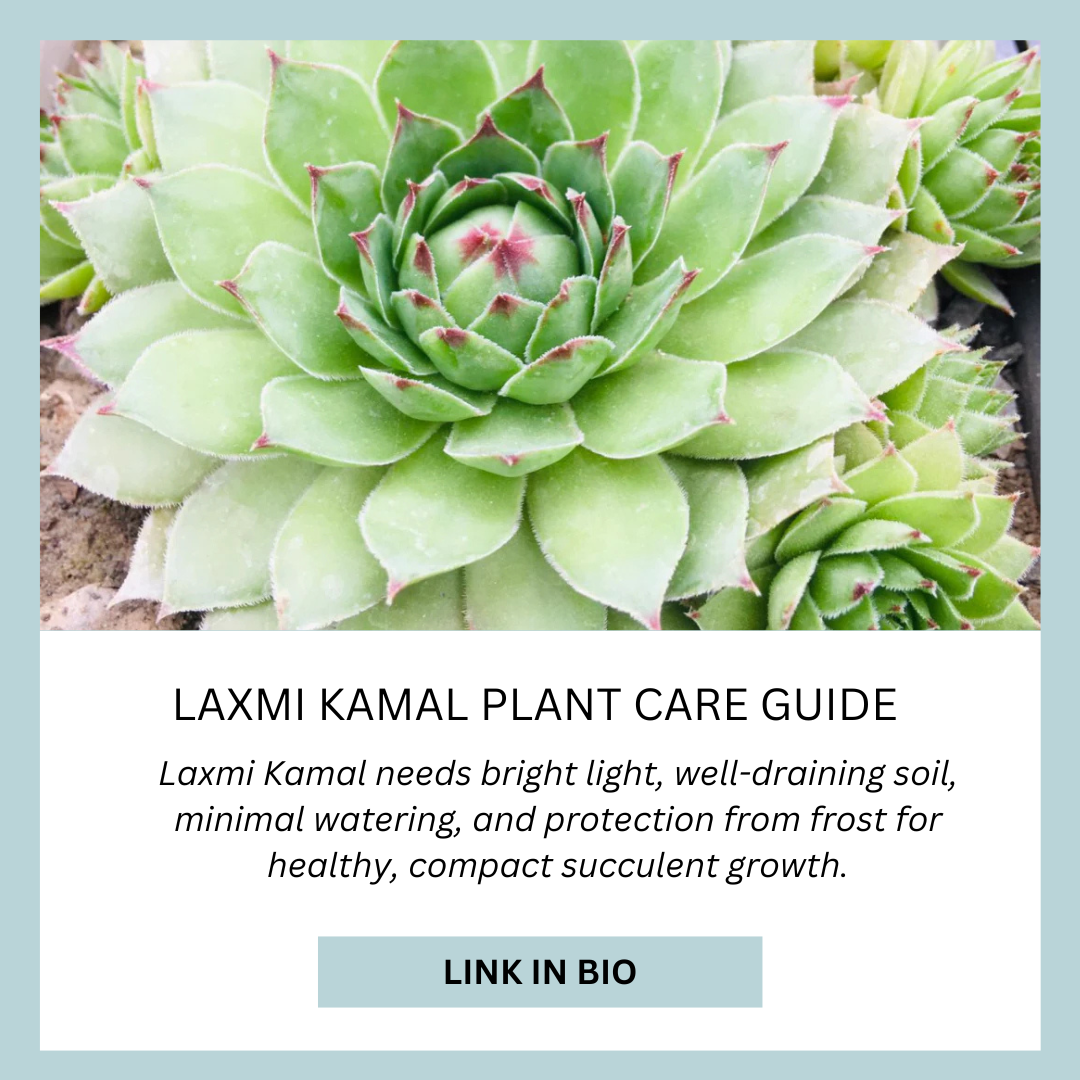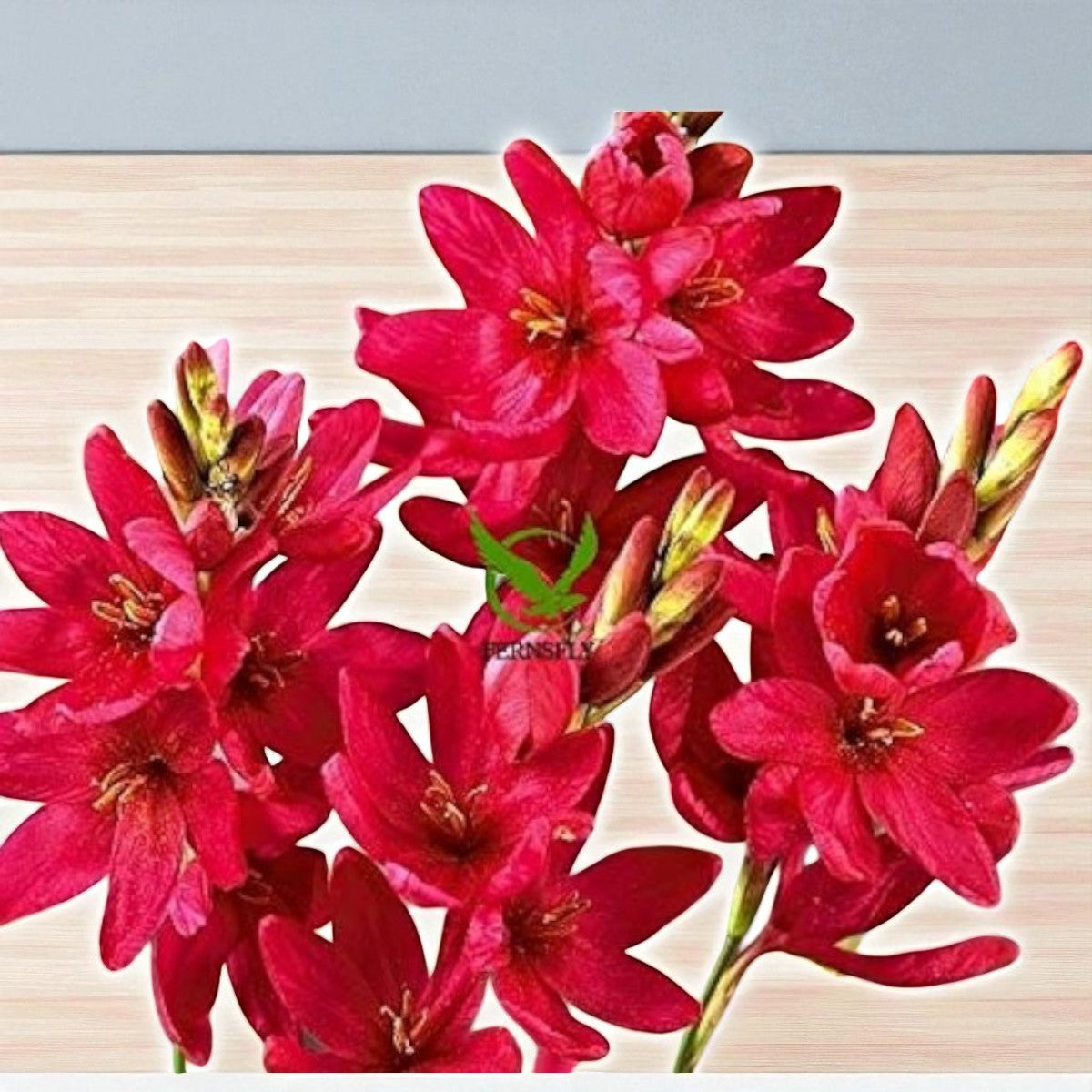
Complete Guide to Growing and Caring for Laxmi Kamal
Complete Guide to Growing and Caring for Laxmi Kamal
Introduction
Laxmi Kamal, scientifically known as Graptopetalum macdougallii, is a charming succulent admired for its ornamental beauty and spiritual significance in Indian households. Its rosette-shaped leaves, compact growth habit, and low maintenance needs make it a favorite for both novice and experienced plant lovers. Believed to bring prosperity, peace, and good fortune, this plant is often associated with the goddess Lakshmi, hence the name “Laxmi Kamal.”
This in-depth guide explores everything from plant characteristics and propagation techniques to soil preferences, seasonal care, and common issues—providing you with all the knowledge you need to grow and nurture a thriving Laxmi Kamal.
🌱 Botanical Profile
-
Common Name: Laxmi Kamal
-
Scientific Name: Graptopetalum macdougallii
-
Plant Family: Crassulaceae
-
Type: Perennial succulent
-
Origin: Native to Mexico
-
Growth Habit: Rosette-forming, mat-spreading
-
Size: Typically 5–10 cm in height, spreads up to 20 cm
🌞 Light Requirements
Laxmi Kamal is a sun-loving plant, but like most succulents, it thrives in bright, indirect sunlight. Direct morning sun can enhance its leaf color and encourage compact, healthy growth. However, excessive afternoon sun in hot climates may scorch the leaves.
Best Practices:
-
Place in a south-facing window indoors or a semi-shaded balcony.
-
Ensure the plant gets 4–6 hours of filtered sunlight daily.
-
If grown indoors, rotate the pot every few days to ensure even exposure and prevent leaning.
🪴 Potting and Soil Mix
Ideal Soil:
Being a succulent, Laxmi Kamal requires a well-draining soil mix to prevent waterlogging and root rot.
Recommended Mix:
-
50% cactus or succulent potting mix
-
25% coarse sand or perlite
-
25% cocopeat or garden soil (for minimal water retention)
Avoid clay-rich or organic-heavy soils as they retain too much moisture.
Pot Selection:
-
Always use a pot with drainage holes.
-
Terracotta or ceramic pots are ideal as they wick away excess moisture.
-
Size should be slightly larger than the rosette diameter to allow airflow and prevent rot.
💧 Watering Needs
Watering is the most critical aspect of succulent care. Laxmi Kamal prefers the “soak and dry” method.
Frequency:
-
Summer: Once a week or when soil is dry
-
Winter: Once in 2–3 weeks
-
Rainy Season: Only if completely dry
Tips:
-
Use room temperature water.
-
Avoid overhead watering; water at the base.
-
Always check the soil's dryness before watering again.
Signs of Overwatering:
-
Mushy or translucent leaves
-
Foul-smelling soil
-
Blackened stems or roots
Signs of Underwatering:
-
Wrinkled or shriveled leaves
-
Dry, crumbly soil
🌡️ Temperature & Humidity
Optimal Temperature:
-
Daytime: 20–30°C
-
Night: 10–20°C
Laxmi Kamal is not frost-tolerant, so during winters, bring the plant indoors or protect it with a greenhouse cover.
Humidity:
-
Prefers low to moderate humidity.
-
Ensure good air circulation to prevent fungal infections.
🌸 Fertilizing
While Laxmi Kamal is not a heavy feeder, a little nutrition during the growing season can enhance growth and flowering.
Fertilizer Type:
-
Use a balanced, diluted succulent fertilizer (NPK 10:10:10).
-
Alternatively, a seaweed extract or organic compost tea can be used occasionally.
Schedule:
-
Spring to Early Fall: Once a month
-
Winter: No fertilizer (dormant phase)
Over-fertilization can lead to leggy growth or burnt roots, so always dilute fertilizers to half strength.
🌿 Pruning and Maintenance
Laxmi Kamal is naturally compact and low-growing, but some maintenance can help it thrive.
Tips:
-
Remove dried or shriveled leaves at the base to prevent pests.
-
Prune leggy stems and encourage rosette clustering.
-
Wipe leaves gently to remove dust.
Repotting:
-
Every 1–2 years or when the plant outgrows its pot.
-
Best time: Early spring
🌱 Propagation
Laxmi Kamal is easy to propagate and doing so can help you expand your succulent garden.
1. Leaf Cuttings:
-
Gently twist off a healthy leaf.
-
Allow it to callous (dry) for 2–3 days.
-
Place on top of dry succulent mix.
-
Mist occasionally until roots and tiny rosettes appear.
2. Offsets (Pups):
-
Mature plants produce small offsets around the base.
-
Gently separate them with roots intact and plant in new pots.
3. Stem Cuttings:
-
Cut healthy stems, allow to callous, and then plant in dry soil.
Care After Propagation:
-
Keep in bright indirect light.
-
Avoid overwatering until roots are established (2–3 weeks).
🐛 Pests and Diseases
Laxmi Kamal is generally pest-resistant, but poor conditions may invite trouble.
Common Issues:
1. Mealybugs:
-
Symptoms: White cotton-like clumps
-
Solution: Dab with neem oil or alcohol-soaked cotton swab
2. Root Rot:
-
Caused by overwatering and poor drainage.
-
Prevent by drying soil completely between watering.
3. Fungal Spots:
-
Black or brown spots on leaves due to moisture or humidity.
-
Improve ventilation and reduce watering.
🌼 Blooming
Laxmi Kamal blooms in the spring or early summer, producing small, star-shaped flowers on long stems. These flowers add an ornamental touch, although the main beauty lies in its foliage.
To Encourage Blooming:
-
Ensure full sun exposure during the day.
-
Fertilize lightly during spring.
-
Keep the plant slightly root-bound.
🛕 Vastu and Spiritual Significance
Laxmi Kamal holds an auspicious place in Indian culture. As the name suggests, it is associated with Goddess Lakshmi, the deity of wealth and prosperity.
Vastu Tips:
-
Place in the northeast direction of the home or office.
-
Keep it clean and dust-free as a mark of respect.
-
Can also be placed in the puja room or entrance to attract positivity.
According to belief, this plant:
-
Brings financial stability
-
Increases peace and calm in the household
-
Shields the home from negative energy
It also makes a great gift during Diwali, housewarmings, or new ventures.
🌍 Seasonal Care Guide
| Season | Watering | Sunlight | Fertilizer | Other Care Tips |
|---|---|---|---|---|
| Summer | Weekly | Bright indirect | Monthly | Avoid harsh afternoon sun |
| Monsoon | Minimal | Filtered light | None | Ensure soil is dry, avoid fungal growth |
| Winter | 2–3 weeks | Indoor sun | None | Move indoors, keep warm and dry |
| Spring | Weekly | Full sun | Monthly | Best time for propagation and repotting |
🧴 DIY Natural Remedies
-
Neem Oil Spray: Prevents mealybugs and fungal infections (Mix 5 ml neem oil + 1 drop soap + 1 L water).
-
Banana Peel Tea: Rich in potassium; acts as a light natural fertilizer.
-
Cinnamon Powder: Sprinkled on cuttings, helps prevent fungal infection during propagation.
🌟 Benefits of Keeping Laxmi Kamal
-
Low Maintenance: Perfect for busy or beginner plant parents.
-
Air Purifying: Like most succulents, it absorbs CO₂ and releases oxygen.
-
Decorative Appeal: Adds a touch of nature and elegance to home décor.
-
Spiritual Upliftment: Associated with prosperity, good luck, and positivity.
🧭 FAQs
Q1: Why are the leaves falling off my Laxmi Kamal plant?
A: It could be due to overwatering or low light. Ensure proper drainage and at least 4 hours of indirect sunlight.
Q2: Can Laxmi Kamal survive indoors?
A: Yes! Place it near a bright window. It’s a perfect indoor plant if it gets enough light.
Q3: How do I revive a dying Laxmi Kamal?
A: Remove rotten parts, repot in dry, well-draining soil, reduce watering, and place in bright light.
📝 Conclusion
Laxmi Kamal is more than just a plant—it's a symbol of wealth, peace, and positivity. With minimal care, it can thrive in small apartments, balconies, or large gardens. Whether you're a plant enthusiast or a believer in Vastu, Laxmi Kamal makes a beautiful and meaningful addition to your home.
By following the tips in this guide—right from soil selection and watering schedules to pest prevention and propagation—you’ll ensure your plant remains healthy and vibrant for years to come.

